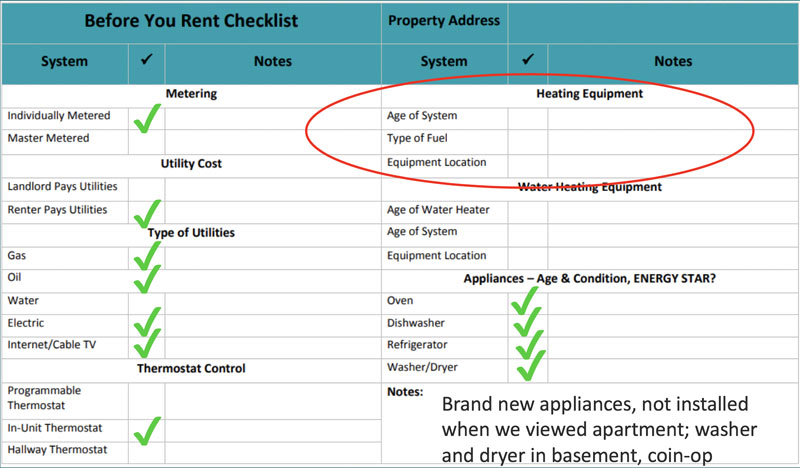By Samantha Caputo | Wed, August 8, 18
As we head into August, we inch closer to the inevitable September 1 rental property turnover in the greater Boston area. With all of the colleges and universities in the area, it is the biggest move-in day in the city.
With this turnover comes the rush to find the perfect apartment in a city where there are more people than apartments to go around. Renters often rush to nab an apartment off the market before the next viewer comes to see it.
I know. I’ve experienced this first hand. I brought my checkbook to the viewing of my current apartment, and my roommates and I fell in love the second we walked in the door. “We love it! Let’s take it!” It was our ideal location near Davis Square, newly renovated, plenty of street parking, green space, and more.
But, we didn’t think to ask very many questions because we wanted to sign on the dotted line to ensure we got the place before anyone else. Even me, as an efficiency nerd, didn’t ask about what energy efficiency upgrades were included in the apartment renovation. It didn’t cross my mind as I was gawking at the hardwood floors and new appliances. There were myriad apartment characteristics listed on the Craigslist ad, but nothing about the energy consumption features or type of fuel the apartment used. In the modern real estate marketplace, this happens more often than not.
NEEP recognized this gap and began developing resources to help renters, buyers, and real estate professionals understand the value of energy efficiency and how to ensure the house that may become your home is a place where energy cost and healthy comfortable features are fully understood and valued.

There is one resource in particular that I wish I had known about at the time I was apartment searching: the Renters’ Checklist. This resource provides a guide for renting and creating lower-cost energy efficient apartments. It includes information on what to look for when viewing an apartment and a checklist of features to investigate before signing a lease, ultimately helping the user understand the amount of energy they may use, and pay for.
If I had this checklist with me when viewing my apartment, I would have known the house used oil for space heating. We discovered this the hard way, during a snowstorm when we ran out of oil and our apartment was 54 degrees. While knowing the apartment used oil for heating would not have changed our minds about renting, it would have helped us better prepare for the winter and budget for oil expenses. This image shows the part of the checklist indicating to ask about heating equipment.

Since there is a split incentive that exists in rental properties, it is important for the renter to understand the “no cost” and “low cost” measures they can take to save money. Some of these include washing clothes in cold water and hang-drying them (which may save you money if you have coin-op laundry), turning the air conditioner off at night to take advantage of “free cooling” with open windows, or using LED light bulbs.
In addition, this guide also helps draw the connection between comfort in the home and the insulation behind the walls, or the number of panes to a window. By understanding the backbones of the building, you are better able to gauge whether you will be comfortable in the building during the winter and summer. My roommates and I are lucky; we are able to keep the thermostats low in the winter and the ACs off in the summer (for the most part) because the apartment has solid insulation.
I recently presented this guide on a Better Buildings Peer Exchange call with hopes that it will reach renters nationwide. This resource has also been co-branded with national organizations, such as Buildings Performance Institute, to make it available to different networks.
By sharing and discussing the relevance and importance of such a guide, NEEP hopes to make energy information more transparent in the real estate transaction. Renters deserve the right to know exactly what they are getting into when signing a lease, especially since the cost of utility bills tends to be the biggest cost (besides rent) for many renters. Be sure to check out the Guide for Renting and Creating Lower Cost Energy Efficient Apartments and Homes and let NEEP know about your experience using it!
